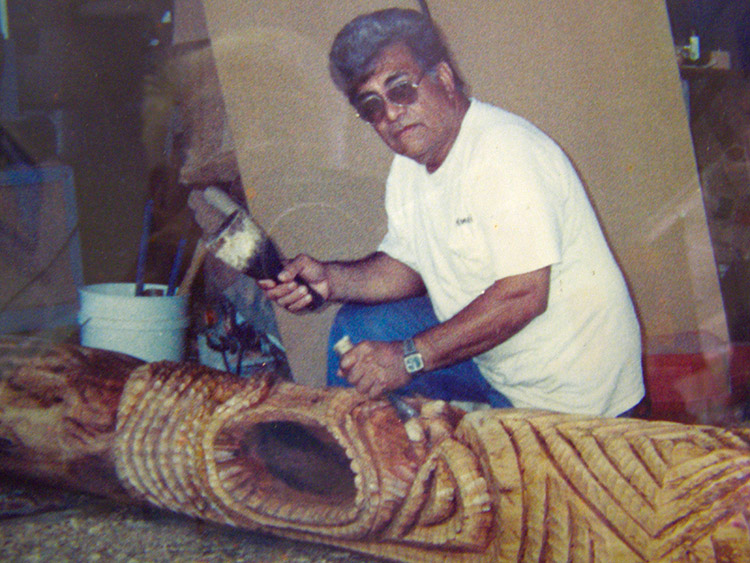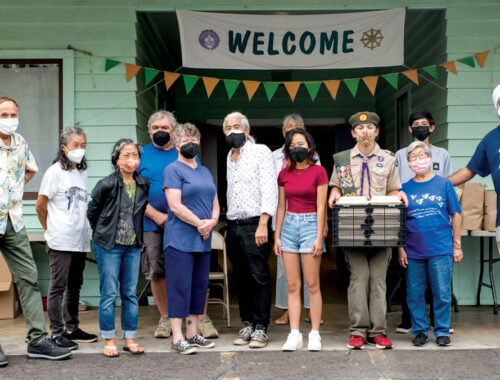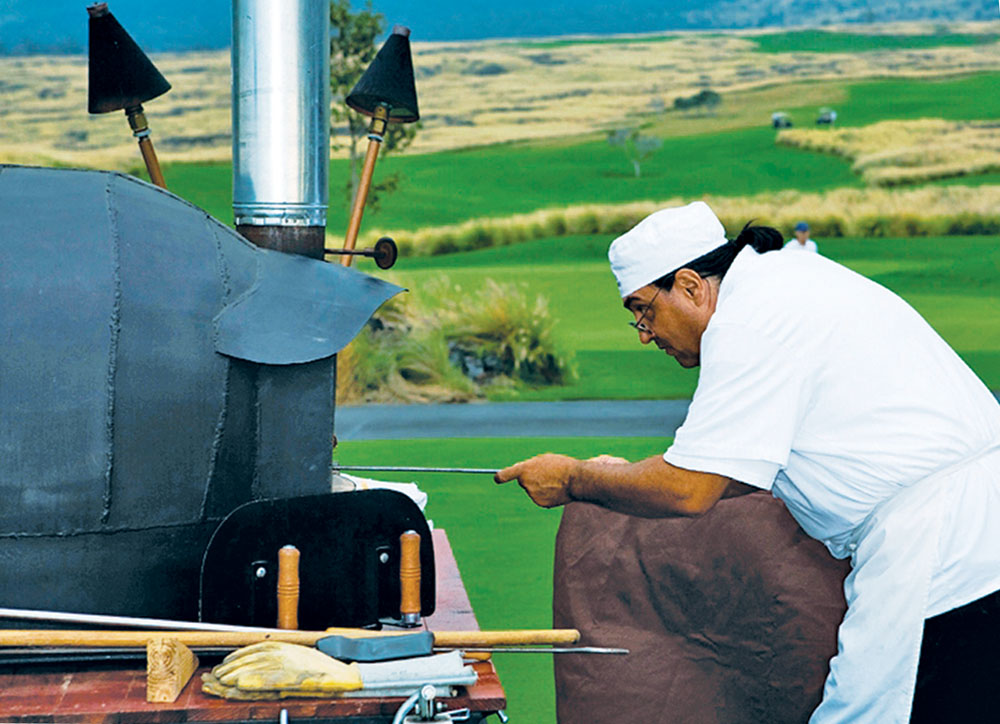
The Bread Line Stops Here
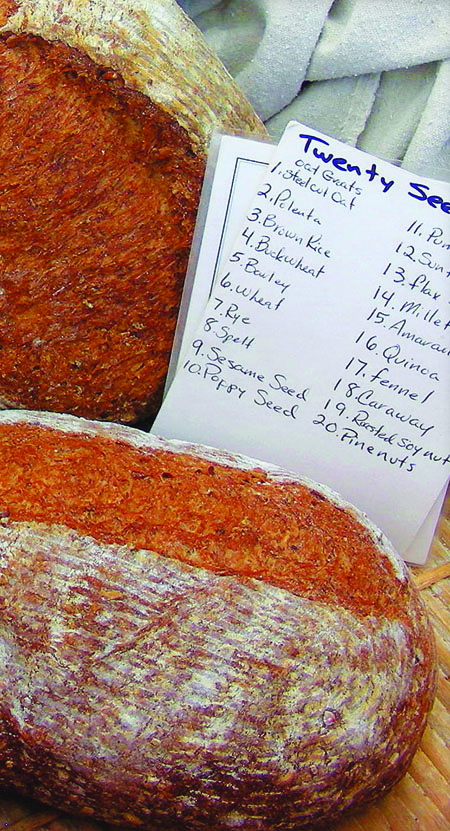
By Catherine Tarleton
It’s a party at the Parker School Farmers Market, and Waimea is at her blue-green, sunny Saturday best. Evangelista and Palafox are rocking and reggae-jamming near the entry gate, between Woody’s tomatoes and the Hamakua coffee stand. On the other side, two guys are deep-frying taro chips, serving up cups of ‘awa to the curious. In the center, polite dogs on leashes stare at kids playing life-sized chess, sniffing hopefully in the direction of Chef Tom’s sizzling breakfast grill. Stretched across the back is Kekela Farms’ display with at least three dozen different veggies; jewel-like roots and leafy greens; plus rich, glisten-y peppers begging to be picked for a still life.
But dominating the corner, with the longest line and most seductive of smells, is Sandwich Isle Bread Company, flagged with the tall smokestack of its Le Panyol oven on the little red trailer.
Smiling and chatting, Kay Cabrera and coworker Karen Warthman happily tempt customers with bread crumbs, cookie crumbles, coconut muffins and cranberry orange scones. A pile of empty baskets on the side speaks to the success of the main event this morning: warm, crisp-crusted, tender-hearted, artisan bread.
“Try it with some of our local Hula Cow butter,” Kay says, nodding at the inevitable mmmm’s. “Isn’t it? He’ll have more bread ready in about half an hour.”
Behind them, “itinerant baker” Kevin Cabrera talks about hearth baking as he places perfectly-shaped loaves of pane pugliese (Italian peasant bread) onto a long-handled peel to slide into the igloo-shaped oven. Each loaf is hand-formed; the ingredients are high quality—organic whenever possible. Pane pugliese is one of up to 16 different varieties of artisan breads, foccacia, pizza rounds and other choices available on a given day.
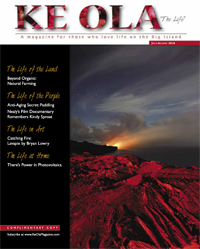
“The attraction to baking for me,” says Cabrera, “is when I have the peel in my hand and I’m pulling the bread out and it’s hot-hot-hot and making that sound and it smells real.” He pauses to check the temperature with a laser thermometer. “I mean, at the resorts, you would plate up 900 dinners for a banquet, with piles of dinner rolls and a display from the freezer,” says Cabrera. “It’s backwards. Faster and more is not necessarily better. That’s the American model for success. But I say keep it small, keep it local. Elevate the community with it.”
Historically, bread has always been a community tradition, as wheat farmers from the surrounding areas would all take their grain to a central village mill to grind it into flour for bread. Millers were some of the earliest bankers, according to Cabrera. “It was all about trust.”
As for ovens, the Egyptians may have invented them. Early bakers used earthenware “tandur” pots, placed mouth-down over a fire to keep heat around the dough as it cooked. Later Greek bakers thought to turn the tandur on its side, with a door in the front. Cabrera’s Le Panyol oven is based on that 2,000-year-old technology.
The dome shape provides very even heat, a critical factor in bread baking. Developed in Provence in the 19th century, the wood-fired oven is constructed of individual tapered refractory bricks made of “terre blanche” (white earth), still quarried from the original location at Larnage. The Cabreras ordered their oven kit from France, by way of Australia, and, with the help of Aphorism Engineering and friends, began welding up a heavy-duty trailer with custom turntable.
Some four months later they received stacks of pre-shaped, individual bricks, bags of “grog” for heat retention and “beton” to seal the joints. Many hands rallied to place bricks, tamp grog, smear slurry, set and let it “proof” for 30 days. Finally fired up with donated kiawe, Le Panyol produced bread for the angels.
“The satisfaction was immense,” says Cabrera. “I wish I had figured out how to do what I wanted to do years ago.”
Kevin and Kay Cabrera (Kay is a well-known pastry chef in her own right) live in Waikoloa Village. Originally from the West Coast, Kevin is the son of an Irish mom and Puerto Rican police-officer dad, and grandson of a chef on the Matson Line, sailing between Hawai‘i and Oakland. In the ‘70s Kevin and Kay came to the Big Island, where they opened a little bakery called Kay’s Creations. “When we go to Hilo, people still ask for her liliko’i tart,” he says.
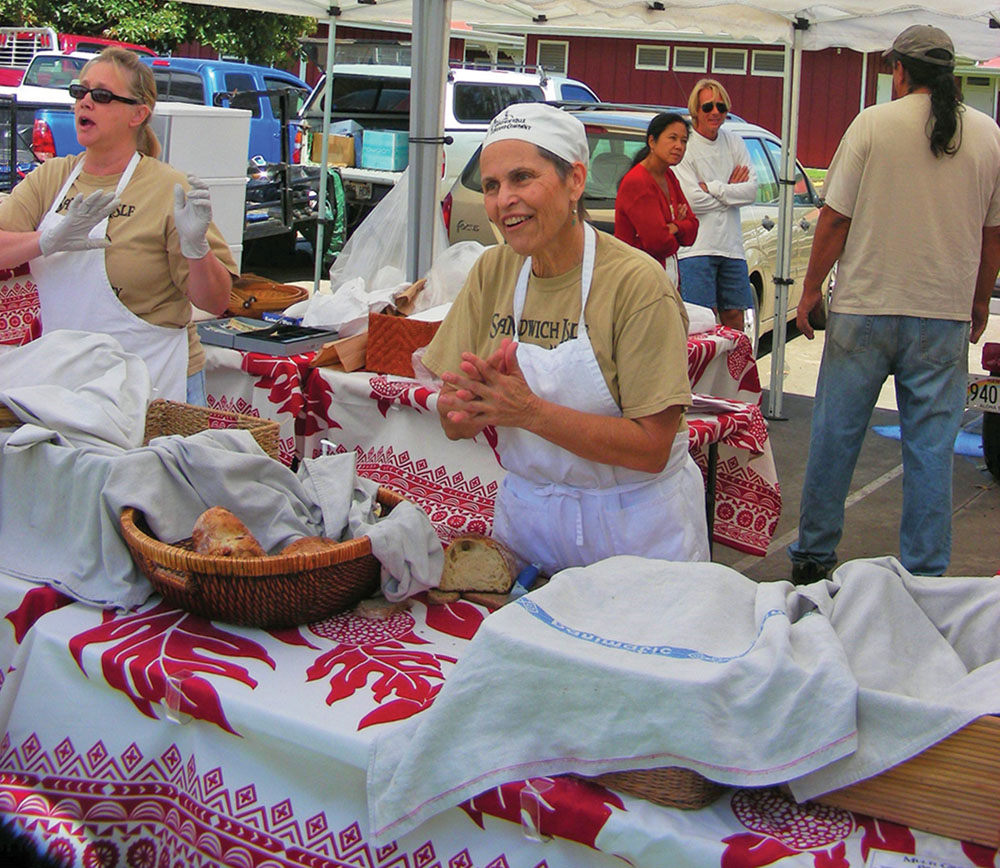
Eventually, resort work drew them to the west side, where Kevin worked with creative chef David Brown at the (then) Hyatt. “He had all these books,” says Cabrera. The Italian Baker by Carol Field, books about Swiss breads, German, French…I kept thinking, ‘I want to make bread that looks like that.’”
At the time they did a lot of work with highly detailed, decorative breads for special events. “Chef David taught me about using shapes that you see in the kitchen for your forms; we made swans from a gravy boat for example. I spent a lot of time in the carpentry shop with him, doing things like turning pears on a lathe. We called it ‘bakentry.’”
During his successful career as baker chef, Cabrera continued to learn and expand his bread repertoire, attending the finals of the Coup de Monde (world cup of bread) at the Artisan Bakers Conference in Los Angeles, baking for statewide Chaine des Rotisseurs galas in Honolulu and teaching workshops through the University of Hawai‘i-Hilo.
In May 2007, Cabrera first saw Le Panyol at the Breadmakers Guild of America “Camp Bread” and decided he wanted one of those babies for his own. He left resort pastry kitchens behind to follow his bliss, at the top of his game.
“People told me they had been waiting for good bread to happen,” says Cabrera. “We got this amazing, amazing reaction from the public.” Today, they have a second, larger oven, a small staff and a six-day baking week that produces more than 400 loaves, all of which usually sell. Big Islanders and mainland visitors from Belgium, Denmark, France and England seek it out religiously. One faithful fan doesn’t even eat bread but loves to see a fresh loaf on the table.
“Macrobiotic diet people are probably our most loyal customers,” said Cabrera. “And we have some vegans, some ‘locavores.’ They buy our pan au levain (a French sourdough) because the starter actually originates here; it’s like ‘Hawaiian yeast.’ Of course the wheat has to come from someplace else.”
Cabrera would love to bring the bread community full circle. “I’m looking for somebody to grow some wheat for me and make some grain. Then we can have somebody mill it and I can take it to a school. Kids eat bread but have never seen where it comes from… It’s one thing to know myself, another thing to share.”
In a down economy, the faithful think nothing of shelling out $20 or more for fresh bread on a Saturday morning. “People feel OK spending that amount of money for that item,” says Cabrera. “It’s impressive to me when people buy more than one loaf. But I always said, if the economy falls completely apart and we’re all broke and out of work, the bread line stops here.” ❖

Olive Bread Panzanella
A “next day” bread recipe from Chef Kay Cabrera, inspired by the flavors of Chef David Brown’s grilled cheese sandwich from the (former) Waikoloa Beach Grill menu.
6 cups leftover olive bread, cut in ½ inch cubes
½ cup good quality olive oil, divided
8 ounces grated fontina cheese
3 tablespoons drained capers
4 cups ½ inch dice fresh tomatoes with their juices
¾ cup thinly sliced sweet onion
½ cup pitted kalamata olives, coarsely chopped (optional)
¼ to ½ cup chopped fresh dill (to taste)
¼ cup balsamic vinegar
sea salt and freshly ground pepper
Preheat oven to 400 degrees.
Spread the cubed olive bread on a half-sheet pan and toss with half the olive oil. Bake until lightly browned, about 12 to 15 minutes, stirring once or twice. When the bread is toasted toss it immediately in a large bowl with the grated fontina cheese, stirring so the cheese melts to the bread. Add the capers, onion, tomatoes with their juice, olives and dill, tossing to blend. Whisk the vinegar and remaining ¼ cup olive oil together and pour over the salad, mixing to evenly coat the bread and vegetables. Season to taste with coarse sea salt and freshly ground pepper. Let rest at room temperature for 30 minutes to an hour so the flavors blend.
Makes 6-8 servings.
For more information, visit www.SandwichIsleBread.com, or follow your nose to find Sandwich Isle Bread at weekly Waimea farmers markets:
Tuesdays, 2-5 p.m. Kekela Farmers Market on Mana Road
Saturdays, 7-10 a.m. Parker School Farmers Market at the intersection of Mamalahoa Highway and Lindsey Road
Wednesday, Thursday, Friday, baking days at Tropical Dreams Ice Cream location, Lalamilo Farm Rd., Waimea (across from Watanabe Floral, Inc.)
Sandwich Isle Bread Company is also available for private pizza parties and bread baking seminars. Call 989.5655, or e-mail SandwichIsleBaker@gmail.com
